
Related
Guests
- Brewster Kahlecomputer engineer, internet entrepreneur, activist and digital librarian. Brewster is the founder of the Internet Archive and the Open Content Alliance, a group of organizations committed to making a permanent, publicly accessible archive of digitized texts. He also is trying to preserve a physical copy of every book ever published — he has already collected over half a million books. Brewster has received a number of awards including the Zoia Horn Intellectual Freedom Award in 2010. Utne Reader named him one of “50 Visionaries Changing Your World.”
- Rick Prelingeran archivist, writer and filmmaker. He is the founder of the Prelinger Archives, a collection of 60,000 advertising, educational, industrial, and amateur films acquired by the Library of Congress in 2002 after 20 years’ operation. Rick has partnered with the Internet Archive to make close to 2,000 films from Prelinger Archives available online for free viewing, downloading and reuse.
As the nation prepares to mark the 10th anniversary of the September 11 attacks, a pair of leading internet archivists are launching an ambitious project called “Understanding 9/11: A Television News Archive,” which catalogs 3,000 hours of domestic and international TV news footage from 20 channels from the week around September 11, 2001. Television news coverage of the September 11 attacks and their aftermath not only documented one of the most important events in mass memory but also influenced public perception. We feature excerpts of coverage from the global archive and speak with its organizers, Brewster Kahle and Rick Prelinger. Kahle is an internet entrepreneur, activist, digital librarian and founder of the Internet Archive and the Open Content Alliance, a group of organizations committed to making a permanent, publicly accessible archive of digitized texts. Prelinger is an archivist, writer, filmmaker and founder of the Prelinger Archives, a collection of 60,000 advertising, educational, industrial and amateur films acquired by the Library of Congress in 2002 after 20 years’ operation. “[9/11] was a major event that was really a television event. People really understood this through television,” says Kahle. He adds that seeing “how people are starting to come to grips with it really shaped how we saw the whole event.” [includes rush transcript]
Transcript
AMY GOODMAN: As the nation prepares to mark the 10th anniversary of the September 11th attacks, a pair of leading internet archivists are launching an ambitious project called the 9/11 TV News Archive. The online archive catalogs 3,000 hours of domestic and international TV news from 20 channels. The footage begins within minutes of the attack on the World Trade Center, as television stations across the world aired images of raging fires, collapsing buildings and a terrified public. Anchors struggled to make sense of the shocking images streaming in from the World Trade Center and Pentagon. Television news coverage of the 9/11 attacks and their aftermath not only documented one of the most important events in mass memory but also influenced public perception.
The 9/11 TV News Archive is being organized by internet archivists Brewster Kahle and Rick Prelinger, who join us today in our New York studio.
Rick Prelinger is an archivist, writer and filmmaker. He’s founder of the Prelinger Archives, a collection of 60,000 advertising, educational, industrial and amateur films acquired by the Library of Congress in 2002 after 20 years in operation. Rick has partnered with the Internet Archive to make nearly 2,000 films from the Prelinger Archives available online for free viewing, downloading and reuse.
We’re also joined by Brewster Kahle, computer engineer, internet entrepreneur, activist, digital librarian. Brewster is the founder of the Internet Archive and the Open Content Alliance, a group of organizations committed to making a permanent, publicly accessible archive of digitized text. He’s also trying to preserve a physical copy of every book ever published. He has already recollected over half a million books. Brewster has received a number of awards, including the Utne Reader’s naming him one of “50 Visionaries Changing Your World.”
We welcome you both to Democracy Now! Brewster Kahle, let’s begin with you. This archive that you are launching today?
BREWSTER KAHLE: Yes, it’s a deep archive that allows people to see news from many different perspectives. The idea is television is worth it, is worth making a record of it, and making it a medium of record, that it’s never been very easy to be able to analyze, compare, contrast or quote television. And television is pervasive and persuasive, yet we’ve never really had the tools to be able to look back, compare and understand what happened to us, as seen through television.
AMY GOODMAN: And so, how did you put this together?
BREWSTER KAHLE: The Internet Archive has been recording television from 20 channels—Russian, Chinese, Japanese, Iraqi, Al Jazeera, BBC, CNN, ABC, Fox—24 hours a day, DVD quality, since late 2000. And so, this was an ongoing record of this recording of these TV broadcasts, because we found that the Library of Congress was not creating a systematic archive, and we weren’t able to find any other source that would be able to make a library.
When the events of September 11th happened, we, as most everybody else, were quite shocked and tried to figure out what it is we can do. And we thought, well, maybe we could actually go and take these materials and help people understand an international perspective of what just happened. And we took 3,000 hours, from September 11th to September 15th, and made it available on the internet for free viewing on October 11th, 2001. This was three years before YouTube. The idea was to try to help people understand the world.
AMY GOODMAN: I want to turn to ABC News’ live coverage of Flight 175 as it crashes into the South Tower. This is one of the videos in the Understanding 9/11 archive.
DON DAHLER: More and more fire and smoke enveloping the very top of the building. And as fire crews are descending on this area, it does not appear that there’s any kind of an effort up there yet. Now, remember—oh, my god!
DIANE SAWYER: My god! My—
CHARLES GIBSON: That looks like a second plane—
DIANE SAWYER: Terrible.
CHARLES GIBSON: —has just hit.
DON DAHLER: I did not see a plane go in. That just exploded.
CHARLES GIBSON: We just saw another plane coming in from the side.
DON DAHLER: You did. That was out of—obscured by my view.
CHARLES GIBSON: Yes, and that’s the second explosion. You could see the plane come in just from the right-hand side of the screen. So this looks like it is some sort of a concerted effort to attack the World Trade Center that is underway.
AMY GOODMAN: Of course, you can hear the shock in the anchors’ voices. Rick Prelinger, what does it mean to have this public record of how reporters respond?
RICK PRELINGER: You know, it seems these days that we often seem to live in an eternal present, this sort of stream of media, and it’s really hard to kind of get one’s bearings. And when we can watch the real-time coverage in context, not just the famous images that get broken out and repeated all over again, but capture the full stream of that day and see how consciousness developed and how events were covered, it gives us a lot of grounding and enables us to begin to really think kind of analytically, critically, about these events and about the way that television works.
AMY GOODMAN: And Brewster, the real-time nature of this?
BREWSTER KAHLE: This was a major event that was really a television event. People really understood this through television. But it was recontextualized very quickly. You see, within hours, it started to be deemed an attack on America. But it wasn’t that way in the beginning. So, how people are starting to come to grips with it really shaped how we saw the whole event. And being able to understand how broadcasts were done, how people reacted, is sometimes a very true nature.
We also can see that news has a point of view. And so, there’s some news organizations that were saying one thing, and other organizations were saying something else. The Russian broadcast—I don’t understand Russian, though the guy is breathless, that he just couldn’t talk fast enough. There was a shock to this, and a sympathy that you could see in all quarters. We started archiving Palestinian television within two days, and it showed a very different perspective than I think what most people think of the response.
AMY GOODMAN: Let’s go to Ambassador Manuel Hassassian of Palestine, claiming the footage used to show Palestinians celebrating on the streets after the 9/11 attacks on the United States were disingenuous. Here’s an excerpt of what he had to say.
AMBASSADOR MANUEL HASSASSIAN: The Palestinians were totally shocked by what had happened. Israel immediately started showing footage, footage that were not related to jubilation by Palestinians about the innocent victims of September 11. The footage that they showed is when Palestinians, in 1993, went down the streets, gave the soldiers the olive branch, and they were in festivity that peace is around the corner. OK? So there was a mix-up there. It was not the Palestinians rejoicing what happened on September 11th.
AMY GOODMAN: Brewster Kahle, were you able to obtain footage of Palestinian media a day after the attack? Talk about how viewers ascertain if what they’re seeing is accurate or just images strewn together.
BREWSTER KAHLE: Well, we’re hoping, by building a library that allows people to go back and analyze and understand these materials, that we can have critical thinking about what is broadcast on television. Television is often an unexamined medium. It just spews by. Unless some clips get put on YouTube or on The Daily Show, it’s just—it passes into consciousness without analysis. And this allows us to use, I think, television as it’s properly used, which is a major informational resource. And by having an ability to move through, browse, dive in, across a timeline, to be able to see how things were unfolding within different countries, across countries, could be a new day on how libraries can be actively available to scholars, general public, journalists, in making these materials much more easily accessible.
AMY GOODMAN: I want to play a clip from CBS Eyewitness News live coverage of 9/11. The anchor makes a point about television today, the immediacy of visual information, even when there’s a dearth of facts on the ground.
CBS ANCHORMAN: Now, we understand yet another building has collapsed in New York. Do we know what building this is? Well, it’s got to be in proximity to one of the two towers. And as the two towers are gone—
CBS ANCHORWOMAN: The two towers are gone.
CBS ANCHORMAN: So it’s got—there’s—OK.
CBS ANCHORWOMAN: Is this a third building now in New York? Yes.
CBS ANCHORMAN: This is the third building. We don’t know—this is the—this is the—some of the problems of technology. And that is that the pictures advance the facts.
AMY GOODMAN: That statement, the challenges, Rick Prelinger, of a medium where the pictures advance the facts. Talk about how television archive helps us to understand events that may seem murky in real time.
RICK PRELINGER: Right, the archive prevents the immediacy and, you know, kind of the drama of an event, but also the doubt and the lack of resolution. And by being able to look back at that stream and compare, we have the chance to understand how events evolve in a more deliberate fashion and to see how these images recur, how an image becomes maybe more than what it originally had been, and how the play of images is translated into meaning and becomes the TV that we know.
AMY GOODMAN: Rick Prelinger, how did you get involved with this project?
RICK PRELINGER: I’m a board member of the Internet Archive. And about 11 years ago, I met Brewster, and he said to me very quickly, “Why don’t you put your collection online?” And I was—after a while, I realized that this was the right thing to do. And we put a lot of our historical film material online, and it’s been used by—I don’t know—hundreds of thousands, millions of people, to make new stuff. Absolutely life-changing experience, and convinced me that archives take on a new life when they’re made available for people for study and research. And that’s—it’s been a long ride, but it’s really tremendous to be able to start to put television before the public.
AMY GOODMAN: I want to turn to a summary of the 9/11 events of the day by BBC World, this, of course, from the—from Archive.org. The anchor refers to the World Trade Center as the landmark of the capitalist world.
BBC WORLD ANCHOR: New Yorkers assumed they were reliving the 1993 bombing of this, one of the most famous landmarks of the capitalist world, but this was to be infinitely more audacious. Some of those trapped inside went to desperate lengths in the hope of rescue. The same desperation led others to jump to an inevitable death. There was pandemonium and panic in the streets around the Trade Center—with good reason, as it turned out, for, within the hour, one of the huge 110-story towers collapsed, and the surrounding area resembled a war zone.
AMY GOODMAN: Brewster Kahle, talk about the different ways people make sense out of the day’s events and why having this diversity of perspectives is so important.
BREWSTER KAHLE: Well, we had, actually, an interesting event happen when we made these materials available. There was a set of people that were—believed there was a conspiracy to cause this event to happen. And one of the pieces of evidence was a BBC broadcast by one of the reporters standing with the World Trade Center 7 behind her, saying that it had collapsed. And this was—this contradiction of having somebody announce something has collapsed when it’s obviously in the background was sort of used as evidence by a particular community. But the BBC’s archive didn’t have that. And this sort of built a sort of distrust. So when a separate library—ours—made it available, then it sort of became a point that allowed people to do some analysis they couldn’t do with the official archives.
AMY GOODMAN: Let’s go to that clip. This is Jane Standley of BBC World reporting the collapse of the second World Trade Center building, approximately 26 minutes prematurely. While Standley spoke, viewers could see the still-standing tower in the background. This actually isn’t the second World Trade Center tower building, this is building number 7.
JANE STANDLEY: Details are very, very sketchy. There’s almost a sense downtown in New York, behind me, down by the World Trade Centers, of just an area completely closed off, as the rescue workers try to do their job. But this isn’t the first building that has suffered as a result. We know that part of the Marriott Hotel next to the World Trade Center also collapsed as a result of this huge amount of falling debris from 110 floors of two—the two Twin Towers of the World Trade Center. As you can see behind me, the Trade Center appears to be still burning. We see these huge clouds of smoke and ash. And we know that behind that, there’s an empty piece of what was a very familiar New York skyline.
AMY GOODMAN: For the record, the BBC publicly stated it’s not part of any conspiracy, and nobody told them what to say on September 11th. Talk about, Brewster, the clip’s significance, especially as you’re talking about those who question the official version of 9/11.
BREWSTER KAHLE: It was a fascinating thing to see it unfold. This was years afterwards, and people were looking for evidence in records. And the BBC’s archive didn’t have a copy of this, as I said. And so, when this came up and we put it up on the net, there was a great deal of interest in this clip and a lot of discussion around where did it really come from and how did we know. So this community was asking us very difficult but proper questions like, “Who are you, this Internet Archive? And can you be trusted? And can this clip be seen as not doctored? And how do you know it was broadcast at any particular time?” So we went back to the original tapes and showed that we laid down a particular time track that matched the other channels, so that we believe that it was recorded at that particular time. And this was going back and forth in the forums on the Internet Archive.
And I guess it really dawned on me that we’ve reached a new age, when somebody was really thoughtfully trying to figure out, “is this a valid clip?” and wrote to me an email and said, “Well, anybody on that forum can say they’re Brewster, but are you really the Brewster Kahle that is running the Internet Archive?” And I wrote back and said, yes, I was, and that that is a valid—you know, I did write those posts. But the idea of provenance and trustability is so malleable at this point. And having institutions and third parties that you can trust with the record, I think, is a very important part, and showing the value of television archives that are available to the general public is something that we must do to be able to have an open democracy.
AMY GOODMAN: We’re going to break and then come back. Our guests are the digital archivists Brewster Kahle and Rick Prelinger. This is Democracy Now! We’ll be back with them in a minute.

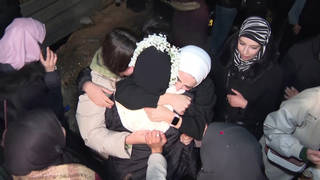
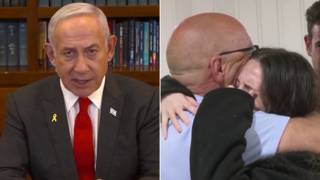
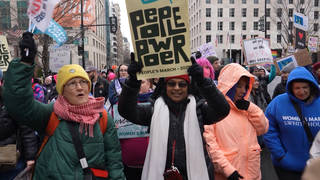
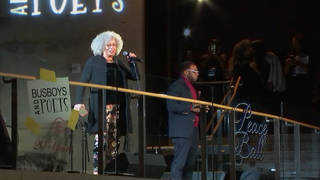
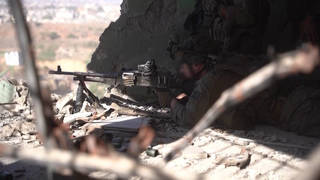




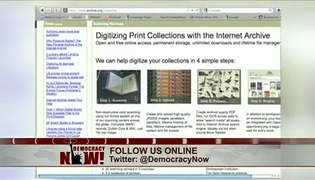
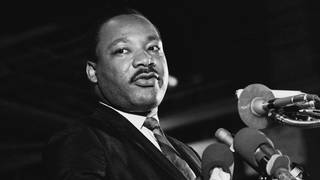
Media Options